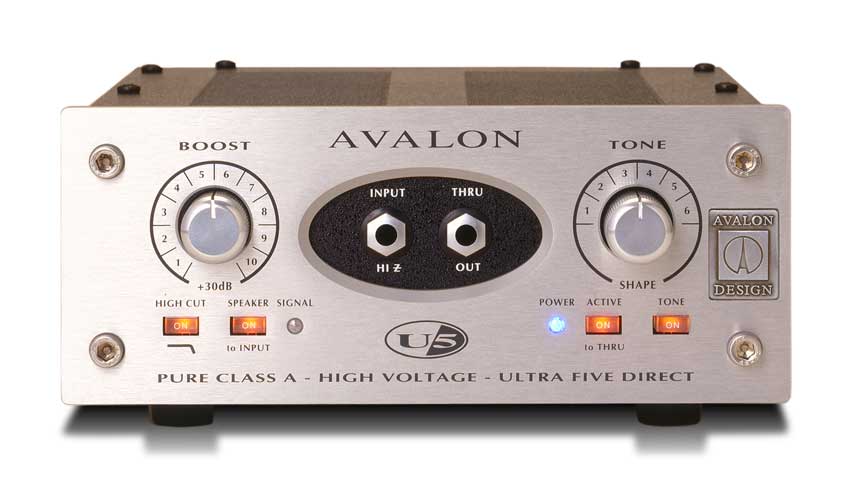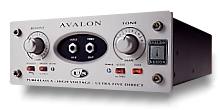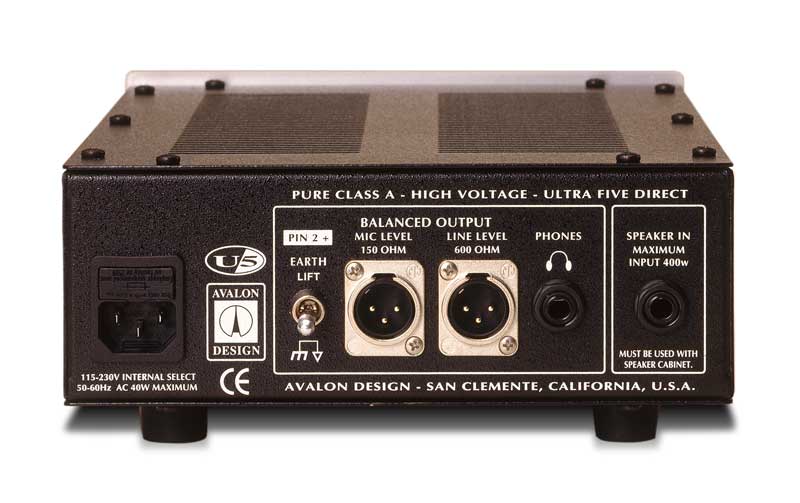|
AVALON DESIGN

U5
High Voltage Direct Box
Tapping Into a Better Direct Sound
| By
Ed Ivey for Onstage Magazine - All Rights Reserved 4/1/01
|
My first bass was an old Gibson EB-something. It had
this chicken-headed “Vari-Tone” knob that yielded wildly different
sounds, from a tinny, single-coil thwack to a sludgy, über-bass
woof. It’s hardly surprising that, twenty years later, the Avalon
U5 High Voltage Direct Box has me pining for that long-lost four-banger.
One good tool can often kindle fond memories of another.
A basic direct box simply takes any high-impedance 1/4-inch instrument
signal and converts it to low-impedance XLR output to send to a mixer.
Over the last decade, dozens of companies have begun offering powered
mono and stereo direct boxes, using tube, solid-state, and hybrid designs.
Avalon Design has made top-quality audio gear since the mid-Eighties.
Their products include Class A vacuum tube and solid state microphone
preamps, tube stereo compressor/EQs, mastering equalizers, opto-compressors,
and more. At $595, the U5 is one of their lower-priced items. Nevertheless,
it reflects Avalon’s mania for sturdiness and function. It’s
expensive as DI’s go, but the U5’s flexibility and features
make the unit worth it for the right user. A live performer who uses
several instruments with varying outputs will love the U5’s adjustable
gain boost and six EQ presets; the studio picker will appreciate the
solid-state unit’s quiet and dependable 100 percent discrete Class
A circuitry.
There’s More To Life Than Ground Lifts
The U5 is two rack spaces tall, one-half rack space
wide, and a foot deep. Avalon’s heavy-duty steel case, attractive
brushed aluminum front panel, and hardy stainless-steel hardware insure
durability.
|
The front panel features a boost knob graduated by click-stop
détentes in 3 dB steps to a total boosted gain of 30 dB,
and a tone knob with six détentes. A high-cut filter switch
reduces everything above 8 kHz by 3 dB. A speaker-to-input switch
activates the U5’s back-panel speaker signal input; a signal
LED triggers at–2 dB for reference. An active-to-thru switch
delivers the U5’s post-boost/EQ signal to external devices.
There’s also a tone defeat switch.
|
|
|
|
The back panel
has a speaker-in 1/4-inch input for converting amp speaker signal
to direct; balanced microphone and line XLR outs, headphones out,
ground lift, and modular AC input. Optional rack ears allow for
single or double-unit installation—a must if the U5 is to be
used live. Every switch emits a “pop” when engaged, but
this is a characteristic of DC-coupled solid-state circuits and
comes with the territory. |
Avalon left out two things some users might miss: a
power switch and a global mute function. This means that, when performing
live, you must depend on a sound tech to mute your channel if you want
to avoid noise.
Instrumentally Effective
The best thing about the U5 is that it has 30 quality dB of boost, mated
with six different EQ shapes that can be switched in an instant. A multi-instrumentalist
who might use three separate DI’s onstage for fiddle, acoustic
guitar, and mandolin—because each instrument has varying output
level and sonic characteristics—will love being able to dial up
a gain setting, notch in an EQ preset, and be playing in seconds. Variable
gain boost is consistent, smooth, and powerful. The U5’s six preset
EQ shapes are well-crafted and extremely useful. (Three of the presets
are gentle variations on a flat EQ, intended for a variety of acoustic,
string, and keyboard instruments; one setting is radically-gutted at
about 900 Hz for electric bass guitar; and the other two have a low-end
roll-off at about 120 Hz for general electric string instruments.)
The U5 upgraded the sonic quality and EQ on every instrument I tried.
My Jay Turser knock-off Beatle bass has an anemic output, but boosting
the U5’s gain to about 20 dB and using tone preset 4—which
emphasized the low-mids—made the Turser’s normally-nasal tone
sound much fuller and rounder, with meaty lows. On the other hand, the
piezoelectric output on my Zeta electric upright bass is insanely bottom-heavy.
House engineers routinely ask me to roll off my low-end by half or more,
often resulting in a loss of warmth. To offset this, I used the U5’s
presets 2 and 5, and set a relatively low boost gain. Boom! There it
ain’t! No more 100 Hz rolling rumble; I was able to return my amp’s
graphic EQ to a less-severe curve, crank my onboard active knobs for
more harmonic riches, and my Zeta sounded punchy, focused, and tight.
Out Of The Doghouse
Then there’s my old Czech plywood string bass with passive Fishman
piezos; it invites feedback in an almost demonic way. I generally use
a Fishman battery-powered outboard preamp to kick the output up, while
hammering the mids down on my Peavey amp’s graphic to kill feedback.
But when the band cranks up, I often end up grabbing my P-Bass to compete
in volume. The U5 might give the old doghouse a fighting chance. Setting
the boost up about 70 percent and using EQ preset 2 strengthened my
signal significantly, while reining in problematic midrange frequencies.
Trying a series of electric and electric-acoustic guitars, both steel
and nylon, furthered confirmed the U5’s tonal diversity. In particular,
it helped my Harmony arch-top with a low-output vintage DeArmond pickup
get appreciably louder than usual before feedback.
Use the Knob, Luke
The Avalon U5 definitely has a place in any studio. It should especially
appeal to home recordists who need a variable-gain DI box they can also
take on gigs. Players who shift between piezo-equipped acoustic instruments
in live performance will find boost and tone settings to compliment
almost any axe. The speaker-input feature is also excellent; I sent
a Fender Twin’s extension speaker-out to the U5 and discovered
deep, creamy low-mids in a Gibson SG’s clean tone that didn’t
have the same punch and clarity running in the active-to-thru mode.
The perfect live use for the U5 might be what I call “cheating
the soundman”—basically, tailoring your DI signal’s gain
and EQ to your own specs before delivering to front of house. A electric
string player using a small mixer to manage several instruments can
send the mono sum to the U5 and control the direct sound that goes to
the house mixer, thus cutting down on extra DI’s and exercising
more personal discretion over his or her sound. Engineers are much less
likely to monkey with your sound if it arrives in quality shape, and
U5 certainly helps make that happen.
Oh, and that old Gibson bass? I smashed it doing a bad imitation of
Pete Townsend at an unremarkable punk gig—impressing nobody—back
when George, Sr. was president. I sheepishly gave the pieces to a guitar
geek the next day, but sometimes I sure do wish I had that “Vari-Tone”
switch back.
BIO Ed Ivey recently traveled to southern Mexico in search of the genuine
banda sinaolense sound. Send e-mail to edivey@rocketmail.com por mas
informacion sobre este sonido suave!
U5 Specifications
Circuit Topology 100% discrete, high-voltage Class A
Gain Switched 3dB steps, maximum gain +30dB
Input Impedance 3,000,000 ohm unbalanced (single ended)
Maximum Input Level +24dBu unbalanced, 400w speaker input
Output Connectors (2) XLR type, pin 2 hot electronic balanced
Maximum Output Level (Class A) +30dBu DC coupled, balanced 600 ohms
(mic and line out)
Headphone Output 0.5w into 600 ohms
Noise 20kHz Unweighted -100dBu minimum gain position
Distortion THD, IMD 0.1% at +10dB
Frequency Response, -/+0.5dB 5Hz to 100kHz
Frequency Response, -3dB 1Hz to 500kHz (input band limited)
High Cut Filter -3dB at 8kHz minimum phase design
Tone Selector Six position rotary switch, all passive filters
AC Power Internal toroidal AC supply
Dimensions 8.5 x 3.5 x 12 in (216 x 88 x 305mm)
Weight 7 lbs (3.2kg)
Rack mount kit (1) RM-1 Single U5 19 inch rack mount kit (holds one
half rack unit)
Rack mount kit (2) RM-2 Dual U5 19 inch

2 U5's with RM-2 rackmount kit
Back to Reviews Index & User List
|




